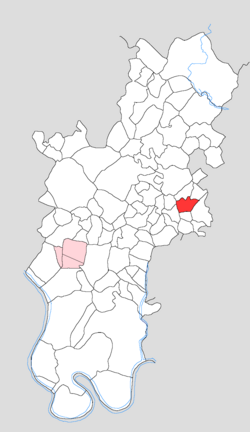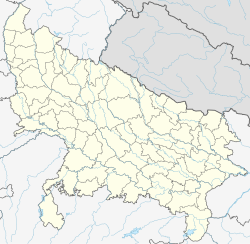Svetlana Velmar-Janković
Garhi Ranchhor | |
|---|---|
Village | |
 Map showing Garhi Ranchhor in Tundla block | |
| Coordinates: 27°15′18″N 78°20′24″E / 27.25511°N 78.34°E | |
| Country | India |
| State | Uttar Pradesh |
| District | Firozabad |
| Tehsil | Tundla |
| Area | |
• Total | 2.225 km2 (0.859 sq mi) |
| Population (2011)[1] | |
• Total | 1,545 |
| • Density | 690/km2 (1,800/sq mi) |
| Time zone | UTC+5:30 (IST) |
Garhi Ranchhor (Gaṛhī Rañchhor) is a village in Tundla block of Firozabad district, Uttar Pradesh. As of 2011, it has a population of 1,525, in 239 households.
Demographics
As of 2011, Garhi Ranchhor had a population of 1,525, in 239 households.[1]: 85 This population was 51.5% male (820) and 47.5% female (725). The 0-6 age group numbered 235 (133 male and 102 female), making up 15.4% of the total population. 97 residents were members of Scheduled Castes, or 6.4% of the total.[2]: 92–3
The 1981 census recorded Garhi Ranchhor (as "Garhi Rachhor") as having a population of 1,032 people (567 male and 465 female), in 181 households and 180 physical houses. It was then counted as part of Kotla block.[3]: 186–7
The 1961 census recorded Garhi Ranchhor as comprising 2 hamlets, with a total population of 728 people (408 male and 320 female), in 125 households and 91 physical houses. The area of the village was given as 548 acres and it had a medical practitioner at that point; it was then counted as part of Kotla block.[4]: xcii
Infrastructure
As of 2011, Garhi Ranchhor had 1 primary school; it did not have any healthcare facilities. Drinking water was provided by hand pump; there were no public toilets. The village did not have a post office or public library; there was at least some access to electricity for all purposes. Streets were made of both kachcha and pakka materials.[1]: 85–90
References
- ^ a b c d "Census of India 2011: Uttar Pradesh District Census Handbook - Firozabad, Part A (Village and Town Directory)" (PDF). Census of India. Retrieved 19 June 2023.
- ^ "Census of India 2011: Uttar Pradesh District Census Handbook - Firozabad, Part B (Village and Town Wise Primary Census Abstract)" (PDF). Census of India. Retrieved 19 June 2023.
- ^ Census 1981 Uttar Pradesh: District Census Handbook Part XIII-B: Village & Town Directory, District Agra (PDF). 1982. Retrieved 25 July 2023.
- ^ Census 1961: District Census Handbook, Uttar Pradesh (22 - Agra District) (PDF). Lucknow. 1965. Retrieved 25 December 2021.
{{cite book}}: CS1 maint: location missing publisher (link)

 Read
Read
 AUTHORPÆDIA is hosted by Authorpædia Foundation, Inc. a U.S. non-profit organization.
AUTHORPÆDIA is hosted by Authorpædia Foundation, Inc. a U.S. non-profit organization.
